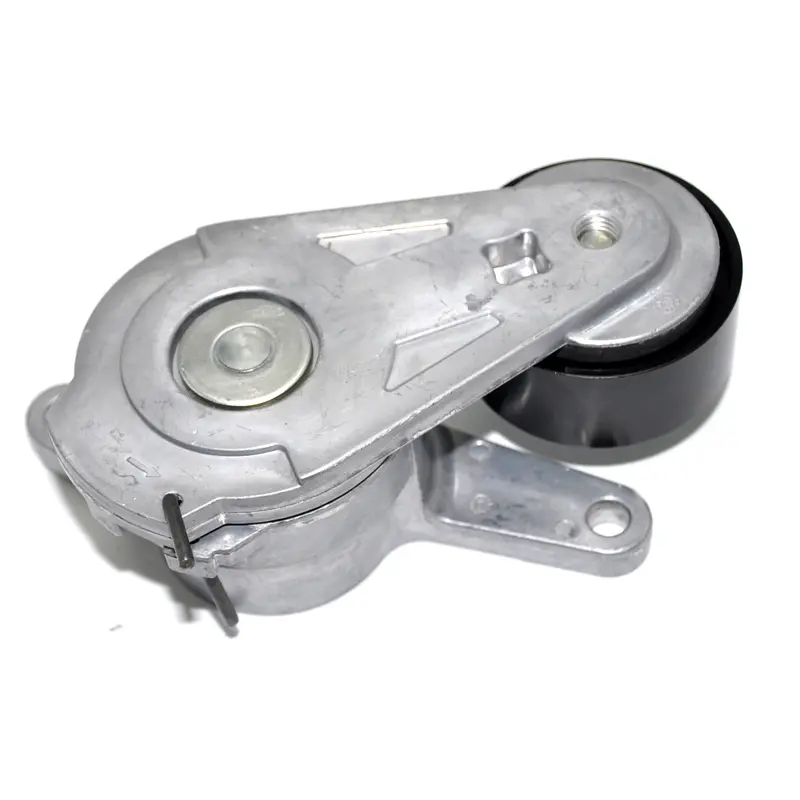Ve světě průmyslových strojů a automobilových aplikací se často zapomíná na komponenty, které zajišťují hladký chod systémů. Jednou z takových klíčových součástí je napínací kladka, zejména v těžkém provedení. Tyto řemenice hrají nezastupitelnou roli při zajišťování efektivního a spolehlivého provozu řemenem poháněných systémů, což je zásadní pro dlouhou životnost a výkonnost strojů, kterým slouží. V tomto článku se budeme zabývat pěti hlavními výhodami používání napínací kladka pro velké zatížení a proč by ji měl každý, kdo chce zvýšit výkon svého zařízení, považovat za nezbytnou modernizaci.
1. Zvýšená odolnost a životnost
Jednou z nejvýznamnějších výhod použití napínací kladky pro vysoké zatížení je její zvýšená odolnost a dlouhá životnost. Tyto řemenice jsou speciálně navrženy tak, aby vydržely náročné požadavky průmyslových a těžkých aplikací. Na rozdíl od standardních řemenic, které se mohou při neustálém namáhání rychle opotřebovávat, jsou kladky pro těžká namáhání vyrobeny z vysoce kvalitních materiálů, jako je zesílená ocel nebo vysoce kvalitní hliníkové slitiny, které vydrží extrémní podmínky.
Vynikající konstrukce těchto řemenic znamená, že jsou méně náchylné k problémům, jako je deformace, praskání nebo předčasné opotřebení, které jsou běžné u lehčích alternativ. Tato odolnost se projevuje delší životností samotné řemenice, což snižuje četnost výměn a údržby, a tím i celkové náklady na vlastnictví. V průmyslových odvětvích, která jsou silně závislá na nepřetržitém provozu, jako je výroba nebo doprava, může prodloužená životnost napínací kladky pro velké zatížení vést k významným úsporám nákladů a snížení prostojů.
2. Vylepšené napnutí a seřízení řemene
Udržování správného napnutí a seřízení řemene je pro efektivní provoz řemenem poháněných systémů zásadní. V této oblasti vyniká napínací kladka pro velké zatížení, která zajišťuje konzistentní a přesnou kontrolu napnutí, což pomáhá předcházet prokluzování, nesprávnému seřízení a nadměrnému opotřebení řemene. To je důležité zejména v prostředí s vysokým zatížením, kde jsou řemeny vystaveny velkému zatížení a nepřetržitému provozu.
Lepší kontrola napnutí, kterou nabízejí řemenice pro velké zatížení, zajišťuje, že řemen zůstává napnutý a vyrovnaný, což snižuje riziko problémů souvisejících s řemenem, jako je přehřátí, roztřepení nebo přetržení. Správné vyrovnání navíc minimalizuje zatížení ostatních součástí systému, jako jsou ložiska a hřídele, což může prodloužit jejich životnost a snížit pravděpodobnost mechanických poruch.
V mnoha případech může použití silných napínacích kladek vést také ke zlepšení energetické účinnosti. Díky udržování optimálního napnutí a vyrovnání řemene vyžaduje systém k provozu méně energie, což může vést ke snížení spotřeby energie a provozních nákladů. Tato výhoda je cenná zejména v rozsáhlých průmyslových provozech, kde je energetická účinnost klíčovým zájmem.
3. Zvýšená nosnost
Další významnou výhodou napínacích kladek pro vysoké zatížení je jejich zvýšená nosnost. V mnoha aplikacích mohou standardní řemenice těžko zvládat vysoké zatížení spojené s těžkými stroji, což vede ke zvýšenému opotřebení a vyšší pravděpodobnosti poruchy. Těžké napínací kladky jsou naproti tomu navrženy tak, aby zvládly mnohem vyšší zatížení, aniž by došlo ke snížení výkonu.
Díky zvýšené nosnosti jsou tyto řemenice ideální pro použití v aplikacích, kde je běžné velké nebo kolísavé zatížení, například u stavebních strojů, zemědělských strojů a ve velkovýrobě. Použitím řemenice, která zvládne větší zatížení, zajistíte spolehlivý provoz zařízení i v těch nejnáročnějších podmínkách.
Kromě toho, že zvládnou vyšší zatížení, přispívají napínací kladky s velkým zatížením také k hladšímu chodu při zatížení. Jejich robustní konstrukce a přesné technické provedení jim umožňují rovnoměrněji rozložit zatížení v celém systému, čímž se snižuje riziko koncentrace napětí, které může vést k poruchám součástí. To nejen zvyšuje spolehlivost systému, ale také pomáhá předcházet nákladným poruchám a opravám.
4. Snížené požadavky na údržbu
Údržba je nezbytným aspektem udržování každého mechanického systému v dobrém provozním stavu, ale nadměrná údržba může vést k prodloužení prostojů a zvýšení provozních nákladů. Těžké napínací kladky jsou navrženy tak, aby minimalizovaly potřebu časté údržby díky své vynikající odolnosti a výkonovým vlastnostem.
Jedním ze způsobů, jak tyto řemenice snižují nároky na údržbu, je minimalizace opotřebení řemene a dalších součástí systému. Jak již bylo zmíněno dříve, lepší napnutí a vyrovnání, které zajišťují řemenice pro vysoké zatížení, pomáhají snižovat opotřebení řemene, což znamená, že řemeny je třeba měnit méně často. Robustní konstrukce těžkých řemenic navíc znamená, že je méně pravděpodobné, že se u nich vyskytnou problémy, jako je selhání ložisek nebo nesprávné seřízení řemenic, což jsou časté příčiny prostojů v systémech poháněných řemeny.
Kromě toho je mnoho napínacích kladek pro vysoké zatížení navrženo s ohledem na údržbu a je vybaveno utěsněnými ložisky nebo samomaznými komponenty, které snižují potřebu pravidelného mazání a kontroly. Toto konstrukční hledisko nejen snižuje čas a úsilí potřebné k údržbě kladky, ale také pomáhá zajistit spolehlivý provoz systému mezi intervaly údržby.
Snížením potřeby časté údržby a s ní spojených prostojů mohou napínací kladky pro velké zatížení přispět k vyšší celkové dostupnosti a produktivitě systému, což je důležité zejména v průmyslových odvětvích, kde prostoje mohou vést k významným finančním ztrátám.
5. Všestrannost a přizpůsobivost
Těžké napínací kladky jsou neuvěřitelně univerzální a přizpůsobivé, takže jsou vhodné pro širokou škálu aplikací v různých průmyslových odvětvích. Ať už pracujete s automobilovými systémy, průmyslovými stroji nebo zemědělskou technikou, těžkou napínací kladku lze přizpůsobit tak, aby splňovala konkrétní požadavky vaší aplikace.
Tyto kladky se dodávají v různých velikostech, materiálech a konfiguracích, takže je lze přizpůsobit jedinečným požadavkům různých systémů. Některé kladky pro vysoké zatížení jsou například navrženy s dalšími funkcemi, jako je tlumení vibrací nebo odolnost proti korozi, takže jsou vhodné pro použití v náročných podmínkách, kde by standardní kladky mohly selhat.
Přizpůsobivost napínacích kladek pro velké zatížení se vztahuje i na jejich kompatibilitu s různými typy řemenů, včetně klínových, hadicových a rozvodových řemenů. Tato univerzálnost znamená, že můžete použít těžkou napínací kladku v téměř jakémkoli systému poháněném řemenem, bez ohledu na konkrétní typ řemene nebo aplikaci.
Kromě fyzické přizpůsobivosti jsou těžké kladky často konstruovány s ohledem na snadnou instalaci a nastavení. Mnoho modelů je vybaveno nastavitelnými napínacími mechanismy nebo rychloupínacími konstrukcemi, které umožňují rychlou a jednoduchou instalaci, což snižuje čas a úsilí potřebné k začlenění kladky do systému.
Díky této všestrannosti a přizpůsobivosti jsou napínací kladky pro velké zatížení vynikající volbou pro širokou škálu aplikací, což zaručuje, že najdete kladku, která splňuje vaše specifické potřeby a zároveň poskytuje odolnost a výkonnostní výhody, které přináší konstrukce pro velké zatížení.
Závěr
Výhody použití napínací kladky pro vysoké zatížení jsou zřejmé. Tyto řemenice nabízejí zvýšenou odolnost a dlouhou životnost, lepší napnutí a seřízení řemene, zvýšenou nosnost, snížené požadavky na údržbu a výjimečnou všestrannost a přizpůsobivost. Pro každého, kdo chce optimalizovat výkon a spolehlivost svých řemenem poháněných systémů, je upgrade na těžkou napínací kladku chytrá investice, která může vést k významným dlouhodobým přínosům.
Ať už provozujete těžké stroje v průmyslovém prostředí, nebo udržujete vozový park, výhody těžké řemenice se mohou projevit ve vyšší efektivitě, zkrácení prostojů a snížení celkových nákladů. Výběrem napínací kladky pro velké zatížení neinvestujete pouze do součásti, ale do dlouhodobého úspěchu a spolehlivosti celého systému.




